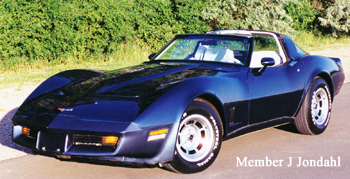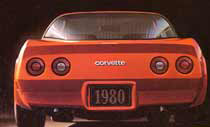
In an effort to get better fuel mileage, the 1980 Corvette went on a weight loss program and shed close to 250 lbs. The hood and the doors were lightened, the glass was fractionally thinner. The roof panels were now made of glass beads. Internally the engineers started to introduce more aluminum with the engine benefiting from an aluminum intake manifold and the differential housing and supports changing over to the lightweight material this year as well. The car got a bit more aerodynamic as well with the introduction of moulded spoilers in the bumper caps.
With this significant weight loss the 1980 Corvette owner was also one who could routinely boast that he could peg his speedo. It was an easy claim as it was the year that the Feds required that speedos could only show a maximum 85 miles per hour. Looking back it seemed a ridiculous, petty and trivial law but those were the days of fuel shortages and the ‘double nickel’ speed limit. For those of you who might wonder why the Fed would legislate something so silly, there was a reason for it. Their thinking was that people would be less likely to push their cars to ‘see how fast it can go’ if the speedo only went up to 85. This, combined with the desire to lower highway speeds to conserve precious fuel, resulted in the mandating of 85 MPH speedometers.
 The cars themselves definitely could go faster, much faster in the case of the optional L-82. The base engine was the 350 cubic inch L- 48 V8 putting out 190 hp and 280 lb. ft. or torque. For the first time since 1974 the Corvette could be ordered with the L-82 engine that upped hp to 230 and torque to 275. Enthusiasts in California had to make do with a 305 with a meager 180 hp and 255 ft. lbs. of torque. California cars could only be equipped with an automatic tranny. As a prelude of things to come the California cars were the first to be equipped with computer engine management. The following year saw the computer setup standard on all Corvettes. The 1980 was also the last year of the reliable and easy to maintain 4- barrel carburetor. For the sake of improved mileage the automatic transmissions now came equipped with a lockup torque converter. Although a 4-speed manual transmission was standard the automatic was a no charge option. The L-82 can easily be identified by an engine identifier on the hood.
The cars themselves definitely could go faster, much faster in the case of the optional L-82. The base engine was the 350 cubic inch L- 48 V8 putting out 190 hp and 280 lb. ft. or torque. For the first time since 1974 the Corvette could be ordered with the L-82 engine that upped hp to 230 and torque to 275. Enthusiasts in California had to make do with a 305 with a meager 180 hp and 255 ft. lbs. of torque. California cars could only be equipped with an automatic tranny. As a prelude of things to come the California cars were the first to be equipped with computer engine management. The following year saw the computer setup standard on all Corvettes. The 1980 was also the last year of the reliable and easy to maintain 4- barrel carburetor. For the sake of improved mileage the automatic transmissions now came equipped with a lockup torque converter. Although a 4-speed manual transmission was standard the automatic was a no charge option. The L-82 can easily be identified by an engine identifier on the hood.New standard equipment for the year included power windows, air conditioning and a tilt/telescopic steering column. In the interior the quickest giveaway that it is a 1980 is the storage area behind the seats has only two doors (down from three). The new weight loss and standard equipment resulted in a jump in price – a $4,000 jump. This resulted in a predictable drop in production numbers.
If you were contemplating a 1980 coupe make sure you check out the T- top seals as the design invariably results in water leaking from the center of the roof. While you are checking out the top seals check the alignment of the coupe doors too as they may contribute to leaks if their alignment is out. Another area where due diligence is needed revolves around the headlights as electrical parts can make repairs expensive. Make sure you also check the vacuum powered headlights and the vacuum powered wiper door. If your new Corvette does not suck you can be stuck with expensive bills from paying a mechanic sleuthing to find the problem.
As a general caveat Vettes from 1968 – 1982 basically share the same body and parts can have been swapped from cars of other years. Unlike most other collectable cars you are very unlikely to find all the original components still on the car. If this is just going to be a daily driver and does not concern you it’s fine. But if you are looking at purchasing a restored car as an investment you should take the car to a knowledgeable expert to determine authenticity. Many will have had different engine and transmission mods done over the years. Some will have had body customizing. All affect value although if you are just buying a good daily driver it should not unduly cause a loss in value. Educate yourself and you can determine what is correct and what is not correct so you don’t pay for something that is not the real McCoy.
Stats:
Production: 40,614 (Base: 32,324, L-82 5,069,
Cal 3,221)
Base price: $13,140
Wheelbase: 98 inches
Overall length 185.3 inches
Height 48.1 inches
Width 69.0 inches
Front Tread 58.7 inches
Rear Tread 59.5 inches
Wheel size 15” X 8”
Tires P225 - 70 - R15
Exterior colors Black, Dark Blue, Dark Brown, Dark
Claret, Red, Silver, White, Yellow,
Frost Beige (White and Black were
the popular colors with black & white
leather seats most common too)
Interior colors Black, red, oyster, claret, dark blue,
and doeskin
Serial Numbers 1Z87L89S400001 - 1Z87L89S453807
The 5th digit varied: 8 = base, 6 = L82
Options:
L-82 225 horsepower engine ($595)
Gymkhana suspension ($55)
California 305 cubic inch motor ($50 credit)
Heavy duty shocks ($35)
Trailer towing package ($105)
Heavy duty battery ($21)
California emissions ($250)
Rear electric defogger ($109)
Cruise control ($123)
Power door locks ($140)
Convenience group ($94)
Sport mirrors with left remote ($45)
AM/FM stereo radio ($46)
AM/FM stereo radio with 8 track ($155)
AM/FM stereo radio with tape player ($168)
AM/FM stereo radio with CB and antenna ($391)
Dual rear speakers ($31)
Radio delete ($126 credit)
Power antenna ($56)
Glass roof panels ($391)
Roof panel carrier ($125)
Aluminium wheels ($407)
255-60-15 tires ($426)